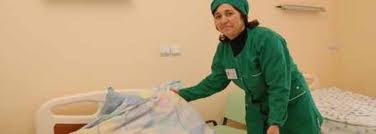Armenia: Armenia Health Profile 2012
2012/02/16
Armenia Health Profile 2012
 The Health System Modernization (HSM) Project has helped increase the geographical and financial access of Armenia’s most vulnerable population to quality basic health services through infrastructure development, provision of modern equipment to health facilities in rural areas, and the upgrading of Primary Health Care (PHC) service providers’ knowledge and skills. About 80% of the country’s population is now covered by retrained family medicine providers. Turning the principal hospital networks in the country’s regions into a high quality health care providers network, accompanied by a development of the PHC infrastructure in rural areas, will eventually reorient regional patient flows from the capital city of Yerevan to local health facilities.
The Health System Modernization (HSM) Project has helped increase the geographical and financial access of Armenia’s most vulnerable population to quality basic health services through infrastructure development, provision of modern equipment to health facilities in rural areas, and the upgrading of Primary Health Care (PHC) service providers’ knowledge and skills. About 80% of the country’s population is now covered by retrained family medicine providers. Turning the principal hospital networks in the country’s regions into a high quality health care providers network, accompanied by a development of the PHC infrastructure in rural areas, will eventually reorient regional patient flows from the capital city of Yerevan to local health facilities.
During the last two decades, Armenia faced enormous economic difficulties and crisis in social spheres, including the health care system. The sharp decrease in state allocations to the health sector, high out-of-pocket payments, dilapidated infrastructure, lack of modern diagnostic equipment, and low motivation of the medical staff to provide quality services created impediments for the population to access quality health services. Consequently, there was an increase in mortality and morbidity rates, especially among the adults. As a result, there is a general concern that people with health problems may postpone seeking care and use of health services because of financial barriers. The main challenge in Armenia’s health system is to ensure better access of the population to quality health services, reduce informal out-of-pocket payments, reallocate the health budget towards the more cost-effective PHC system, and rationalize health service provision, including the optimization of excess capacity in the hospital sector.
Approach
 The HSM Project has been designed to improve the organization of the country’s health care system so as to provide more accessible, quality and sustainable health care services to the population, in particular, to the most vulnerable, and to better manage public health threats. The HSM Project continues to support the government efforts to: (i) complete the family medicine-based PHC reform that was launched in 1996; (ii) consolidate the hospital sector to minimize waste of scarce resources and improve quality of care; and (iii) strengthen the government’s capacity for effective stewardship in policy making.
The HSM Project has been designed to improve the organization of the country’s health care system so as to provide more accessible, quality and sustainable health care services to the population, in particular, to the most vulnerable, and to better manage public health threats. The HSM Project continues to support the government efforts to: (i) complete the family medicine-based PHC reform that was launched in 1996; (ii) consolidate the hospital sector to minimize waste of scarce resources and improve quality of care; and (iii) strengthen the government’s capacity for effective stewardship in policy making.
Results
To date, the HSM Project has supported the following key outcomes:
- About 1,182 physicians were re-trained as family physicians; 144 physicians are in the process of re-training; 1,306 nurses have been re-trained as family nurses; 133 nurses are in the process of re-training.
- The infrastructure of 70 PHC facilities located in rural areas has been improved (26 new construction and 44 renovations).
- A total of 200 PHC facilities have been provided with standard sets of medical equipment, supplies, furniture and information technology (IT) equipment.
- Three hospital mergers (“Yerevan State Medical University,” “Surb Grigor Lusavorich,” and “Surb Astvatsamayr” Medical Center) have been provided a modern biomedical and IT equipment.
- The Kotayk region Hrazdan Medical Center (MC) (population of 105,300), Tavush region Ijevan MC (population of 49,200) and Armavir region Armavir MC (population of 121,500), Ararat region Ararat MC (population of 95,500) have been renovated and provided with modern medical equipment and furniture.
- Aragatsotn region Aparan MC (population of 22,400), Syunik region Goris MC (population of 44,700) and Gegharkunik region Gavar MC (population of 57,800) are currently under renovation.
- About 726 managers of hospital facilities, including 108 top-level, 271 mid-level and 347 lower-level managers, have received management training courses developed by international consultants. As a result, 48 regional hospitals have trained key management staff.
- Health System Performance Assessment reports for 2006 and 2008 were developed, published and distributed among stakeholders. The reports demonstrated the positive impact of the government’s health reforms on improving the quality of and access to health services for the population.
- National Health Account (NHA) reports for 2004-2008 were developed. NHA reports for 2006 and 2008 were published and distributed among stakeholders. These analytical reports presented invaluable information on the sources and volumes of financial flows in the sector, and provided an opportunity for decision-makers to assess and revisit the results of the ongoing health reforms and make essential policy adjustments.
Toward the Future
Future plans of the government of Armenia are to: continue upgrading health facilities as outlined in the optimization plans in all regions, continue and improve the quality of training of family practice teams, carry out training of health professionals of secondary-tertiary specialty areas, and continue activities that support institutional strengthening, such as an introduction of performance–based payment of providers, and improved governance and regulatory arrangements, which would make the project sustainable in the long run.
The Republic of Armenia is one of the Caucasus countries. With a surface area of 29 800 km2, it is
administratively divided into eleven provinces (marz), one of which is the capital – Yerevan. The Republic of Armenia declared independence in 1991 and entered a period of radical and fundamental political, social and economic reforms. Despite some progress in setting up basic democratic and market institutions, Armenia remains classified as a lower middle income country, according to the World Bank index of "governance atmosphere", which covers the effectiveness and quality of governance, rule of law, level of corruption, political stability, and civil liberties. The percentage of the population living below the poverty line is 42.9 (UNDP Human Development Report, 2004). Officially, services account for 40% of the GDP, industry for 25%, the agricultural sector for 20% and construction for 15%.
HEALTH AND DEVELOPMENT
Demographic situation: The general mortality rate per 1000 increased from 5.7 in 1986 to 8.2 in 2005, and the natural growth rate of the population declined from 18.3 to 3.5 per 1000a. Main causes of mortality: Eighty-three per cent of deaths in Armenia are attributed to noncommunicable diseases followed by external causes (3%), communicable diseases (1%), and ill-defined conditions (4%). The leading causes of premature death (under 65) in Armenia are, in order of magnitude, diseases of the circulatory system, cancer, external injuries and poisoning.
Maternal and child health has improved in recent years: Although there is a discrepancy between the nationally-reported data, WHO estimated data, and data from various surveys, all sources testify to the declining trend in infant, child, and maternal mortalityc. In spite of positive immunization results (e.g. achievement of the status of a polio-free region), the coverage rate of fully-immunized children, valid by recommended age, dropped to 42.3% in 2006 despite adequate vaccine supplies.
Lifestyle-associated health problems: Tobacco consumption is rising rapidly, varying between 64.2% and 69.4% among men in the 24–65 years age group. The prevalence of smoking among women is also on the rise, comprising 2.2%. Alcohol is not a big problem in Armenia so far; however, it is becoming more popular among those in the youngest age group (16–24). Unhealthy diet, obesity and low physical activity are common.
Tuberculosis (TB) has become an important public health problem with an estimated total incidence of 77 new TB cases and 35 new pulmonary smear-positive TB cases per 100 000f. Theprevalence of multi-drug-resistant TB is estimated to be 12% and 57% in new and previously-treated patients respectively. The DOTS (Directly Observed Treatment, short course) is currently being implemented nationwide, including the penitentiary system. However, not all TB patients are properly registered and the case detection and treatment success rates are low g. The prevalence of HIV/AIDS in the adult population was about 0.1% in 2005.
Sixty-one percent of health funding is paid out of pocket at the point of service : This imposes a large barrier to health care access and a financial risk for many Armenians. Apart from foreign sources, the general tax revenue is the only pre-paid source of health funding. However, the large share of unofficial out-of-pocket payments (OOPs) and the low priority given to health by the Government limit the available public resources (1.64% of GDP, 2006)i. The Ministry of Health manages the health budget and the State Health Agency is responsible for purchasing a defined Basic Benefits Package (BBP) for the population. In 2006, there was a 21% increase in the Government budget for the health sector, most of which was spent on primary health care.
OPPORTUNITIES
- BBP covers not only primary care but also inpatient services for certain socially vulnerable groups and treatment of certain diseases and medical conditions for the whole population (TB,oncology, urgent care, etc).
- The Government has committed itself to continuing the health reform with emphasis on prevention, family care and community participation, and on reducing problems of financial protection and the barriers to health careaccess associated with this high share of OOPS.
- In the last decade, Armenia has experienced strong economic growth and reduced poverty rates with potential positive effects on health andequity.
CHALLENGES
- Poor use is made of the health information system for decision-making
- The BBP is not based on real costs of health careservices and thus contributes to unofficial payments.
- The essential drug list is not in active use. There isa wide practice of prescribing expensive brands that a large part of the population cannot afford.
- There is a lack of modern technology and equipment.
- TB and HIV services are too vertical and not well integrated in the overall health system
- There are skill imbalances, mal-distribution of health professionals, lack of incentives to attract health workers to remote rural areas and lack of infrastructures for continuous professional development.
- Armenia News
-
- AFGHANISTAN: The newly created Eurasian Economic Union (EEU) has shortly got the momentum
- ARMENIA: 2015 Euro-Asia Economic Forum in Xi'an,
- ARMENIA: EU-funded project: round table on ethics and disciplinary issues in Georgian Bar Association
- ALBANIA: TAP starts construction of access roads, bridges in Albania
- AFGHANISTAN: Revised IMF forecasts signal gloom on global economic outlook
- AFGHANISTAN: Oxfam Study Finds Richest 1% Is Likely to Control Half of Global Wealth by 2016
- Trending Articles
-
- FRANCE: Cavendish doing it for Africa
- CONGO BRAZZAVILLE: Congo: Total abandons oil field citing decrease in global oil prices
- SOUTH AFRICA: South Africa’s Biggest Labor Group to Balance Pay With Job Security
- EUROPEAN UNION: EU meets without Britain for first time since Brexit vote
- NIGERIA: Lagos hosts 2016 Africa fashion week Nigeria
- KENYA: Nairobi to host 14th UN conference on trade and development





